

by Holli Riebeek· design by Robert Simmon· December 19, 2005 Richard Alley might have envied paleoceanographer Jerry McManus’ warm, ship-board lab. (See previous installment: “A Record from the Deep.”) One of the researchers in the Greenland Ice Sheet Project 2 (GISP2), Alley huddled in a narrow lab cut into the Greenland Ice Sheet, where “the temperature stayed at a ‘comfortable’ twenty below [Fahrenheit],” he wrote in his book about his research, The Two-Mile Time Machine. An assembly line of science equipment lined the twenty-foot-deep trench that served as a makeshift lab. For six weeks every summer between 1989 and 1993, Alley and other scientists pushed columns of ice along the science assembly line, labeling and analyzing the snow for information about past climate, then packaging it to be sent for further analysis and cold storage at the National Ice Core Laboratory in Denver, Colorado. Nearby, a specially built drill bored into the thick ice sheet twenty-four hours a day under the perpetual Arctic sun. Essentially a sharpened pipe rotating on a long, loose cable, the drill pulled up cores of ice from which Alley and others would glean climate information. |
| ||
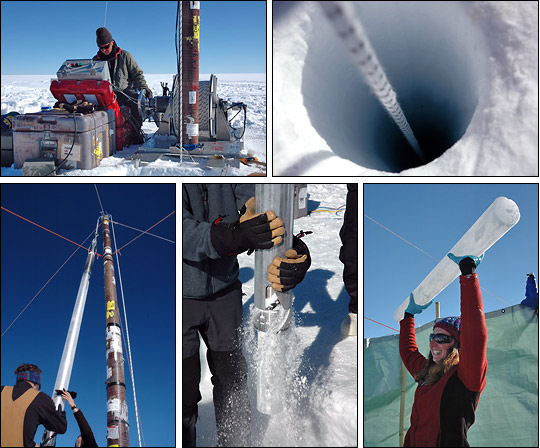 | |||
Throughout each year, layers of snow fall over the ice sheets in Greenland and Antarctica. Each layer of snow is different in chemistry and texture, summer snow differing from winter snow. Summer brings 24 hours of sunlight to the polar regions, and the top layer of the snow changes in texture—not melting exactly, but changing enough to be different from the snow it covers. The season turns cold and dark again, and more snow falls, forming the next layers of snow. Each layer gives scientists a treasure trove of information about the climate each year. Like marine sediment cores, an ice core provides a vertical timeline of past climates stored in ice sheets and mountain glaciers. |
Ice sheets contain a record of hundreds of thousands of years of past climate, trapped in the ancient snow. Scientists recover this climate history by drilling cores in the ice, some of them over 3,500 meters (11,000 feet) deep. These photographs show experimental drilling on the Greenland Ice Cap in summer 2005. (Photographs copyright Reto Stöckli, NASA GSFC) | ||
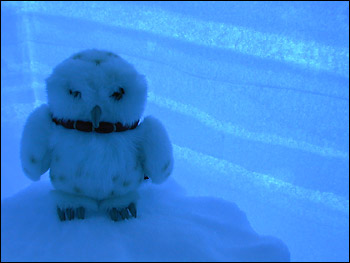
The seasonal snow layers are easiest to see in snow pits, writes Alley, the Evan Pugh Professor in the Environment Institute and Department of Geosciences at Pennsylvania State University. To see the layers, scientists dig two pits separated by a thin wall of snow. One pit is covered, and the other is left open to sunlight. By standing in the covered pit, scientists can study the annual snow layers in the snow wall as the sunlight filters through the other side. “I have stood in snow pits with dozens of people—drillers, journalists, and others—and so far, every visitor has been impressed. The snow is blue, something like the blue seen by deep sea divers, an indescribable, almost achingly beautiful blue,” writes Alley. “The next thing most people notice is the layering.” |
Blue light filtered through the wall of an Antarctic snow pit illuminates "Tuck," the mascot for Tuckahoe Elementary School in Henrico County, Virginia. The furry white owl accompanied scientists to Antarctica as part of an educational program. In the wall of the pit, dark and light bands of slowly compacted snow distinguish snow deposited in the winter from snow deposited in the summer. (Photograph courtesy Christopher Shuman, NASA GSFC) | ||

To pry climate clues out of the ice, scientists began to drill long cores out of the ice sheets in Greenland and Antarctica in the late 1960s. By the time Alley and the GISP2 project finished in the early 1990s, they had pulled a nearly 2-mile-long core (3,053.44 meters) from the Greenland ice sheet, providing a record of at least the past 110,000 years. Even older records going back about 750,000 years have come out of Antarctica. Scientists have also taken cores from thick mountain glaciers in places such as the Andes Mountains in Peru and Bolivia, Mount Kilimanjaro in Tanzania, and the Himalayas in Asia. |
The gradually increasing weight of overlying layers compresses deeply buried snow into ice, but annual bands remain. Relatively young and shallow snow becomes packed into coarse and granular crystals called firn (top: 53 meters deep). Older and deeper snow is compacted further (middle: 1,836 meters). At the bottom of a core (lower: 3,050 meters), rocks, sand, and silt discolor the ice. (Photographs courtesy U.S. National Ice Core Laboratory) | ||
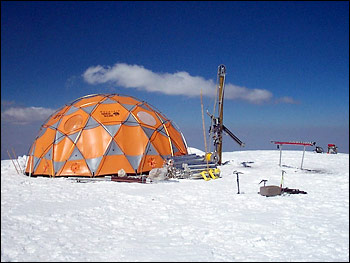
The ice cores can provide an annual record of temperature, precipitation, atmospheric composition, volcanic activity, and wind patterns. In a general sense, the thickness of each annual layer tells how much snow accumulated at that location during the year. Differences in cores taken from the same area can reveal local wind patterns by showing where the snow drifted. More importantly, the make-up of the snow itself can tell scientists about past temperatures. As with marine fossils, the ratio of oxygen isotopes in the snow reveals temperature, though in this case, the ratio tells how cold the air was at the time the snow fell. In snow, colder temperatures result in higher concentrations of light oxygen. (See The Oxygen Balance.) |
Researchers retrieve climate records from mountain glaciers in addition to the records from polar ice sheets. Drilling sites around the world help distinguish trends in local climate from trends in global climate. This drilling station is located at an elevation of 6,425 meters (21,080 feet) on the summit of Nevado Coropuna in the Peruvian Andes. (Photograph copyright Jason Box, Ohio State University/Byrd Polar Research Center) | ||
Scientists can confirm these chemistry-based temperature measurements by observing the temperature of the ice sheet directly. The ice sheet’s thickness makes its temperature much more resistant to change than the six inches of snow that might fall on your driveway during a winter snowstorm. As Alley explained to the Earth Observatory, the ice sheet can be compared to a frozen roast that is put directly into the oven. The outside heats up quickly, but the center remains cold, close to the temperature of the freezer, for a long time. Similarly, the ice sheet has warmed somewhat since the Ice Age, but not completely. The top has warmed as global temperatures have warmed, while the bottom has been warmed by heat flow from deep inside the Earth. But in the middle of an ice sheet, the ice remains close to the Ice Age temperatures at which it formed. “Because we understand how heat moves in ice, [and] we know how cold the ice is today, we can calculate how cold the ice was during the Ice Age,” says Alley. |
The ice core recovered from Vostok, Antarctica, records over 400,000 years of climate history. This interactive graph shows temperature measurements derived from the core. Temperatures equal to or greater than the recent average (gray line) delineate interglacial periods, while colder temperatures indicate ice ages. Scroll the graph in time by dragging the slider on the miniature graph (lower). Zoom in and out on the data with the plus and minus buttons (lower left). [Interactive designed by Kristin Henry, (Galaxy Goo) and Robert Simmon (NASA GSFC)] | ||
 |
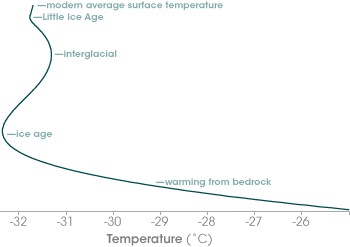
When scientists lower an ultra-precise thermometer into a hole in the ice, they can detect the temperature variations that have occurred since the Ice Age. The near-surface ice temperature, like the atmosphere today, is warm, and then the temperature drops in the layers formed roughly between AD 1450 and 1850, a period known as the Little Ice Age, one of several cold snaps that briefly interrupted the overall warming trend ongoing since the end of the Ice Age. As the thermometer goes deeper into the ice sheet, the temperature warms again, and then plummets to the temperatures indicative of the Ice Age. Finally, the bottom layers of the ice sheet are warmed by heat coming from the Earth. These directly measured temperatures represent a rough average—a record of trends, not variable, daily temperatures—but climatologists can compare the thermometer temperatures with the oxygen isotope record as a way to calibrate those results. |
Scientists measure the temperature of an ice sheet directly by lowering a thermometer into the borehole that was drilled to retrieve the ice core. Like an insulated thermos, snow and ice preserve the temperature of each successive layer of snow, which reflects general atmospheric temperatures when the layer accumulated. Close to the surface of the bedrock, the lowest layers of the ice are warmed by the heat of the Earth. These physical temperature measurements help calibrate the temperature record scientists obtain from oxygen isotopes. (Graph based on data provided by Gary Clow, United States Geological Survey) | |
As valuable as the temperature record may be, the real treasure buried in the ice is a record of the atmosphere’s characteristics. When snow forms, it crystallizes around tiny particles in the atmosphere, which fall to the ground with the snow. The type and amount of trapped particles, such as dust, volcanic ash, smoke, or pollen, tell scientists about the climate and environmental conditions when the snow formed. As the snow settles on the ice, air fills the space between the ice crystals. When the snow gets packed down by subsequent layers, the space between the crystals is eventually sealed off, trapping a small sample of the atmosphere in newly formed ice. These bubbles tell scientists what gases were in the atmosphere, and based on the bubble’s location in the ice core, what the climate was at the time it was sealed. Records of methane levels, for example, indicate how much of the Earth wetlands covered because the abundance of life in wetlands gives rise to anaerobic bacteria that release methane as they decompose organic material. Scientists can also use the ice cores to correlate the concentration of carbon dioxide in the atmosphere with climate change—a measurement that has emphasized the role of carbon dioxide in global warming. (see “Explaining the Evidence.”) Finally, anything that settles on the ice tends to remain fixed in the layer it landed on. Of particular interest are wind-blown dust and volcanic ash. As with dust found in sea sediments, dust in ice can be analyzed chemically to find out where it came from. The amount and location of dust tells scientists about wind patterns and strength at the time the particles were deposited. Volcanic ash can also indicate wind patterns. Additionally, volcanoes pump sulfates into the atmosphere, and these tiny particles also end up in the ice cores. This evidence is important because volcanic activity can contribute to climate change, and the ash layers can often be dated to help calibrate the timeline in the layers of ice. | 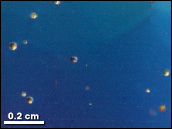
Air bubbles trapped in the ice cores provide a record of past atmospheric composition. Ice core records prove that current levels of carbon dioxide and methane, both important greenhouse gases, are higher than any previous level in the past 400,000 years. (Photograph courtesy U.S. National Ice Core Laboratory) | ||
 | |||
Though ice cores have proven to be one of the most valuable climate records to date, they only provide direct evidence about temperature and rainfall where ice still exists, though they hint at global conditions. Marine sediment cores cover a broader area—nearly 70 percent of the Earth is covered in oceans—but they only give tiny hints about the climate over the land. Soil and rocks on the Earth’s surface reveal the advance and retreat of glaciers over the land surface, and fossilized pollen traces out rough boundaries of where the climate conditions were right for different species of plants and trees to live. Unique water and rock formations in caves harbor a climate record of their own. To understand the Earth’s climate history, scientists must bring together all of these scattered threads into a single, seamless story.
|
Ash from volcanic eruptions becomes trapped in ice sheets along with snow and dust. Scientists use the volcanic ash found in ice cores to date the cores and to estimate the intensity of past volcanic activity. This satellite image shows black ash from the eruption of Hekla on top of bright white Icelandic snow on February 29, 2000. (NASA image courtesy Jesse Allen) | ||